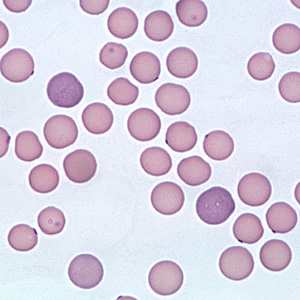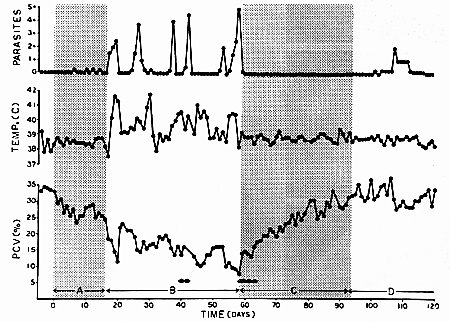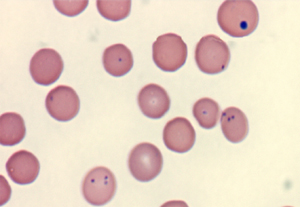Mycoplasma haemofelis (formerly
Haemobartonella felis) is an epicellular
bacterial parasite of feline red cells that can cause hemolytic anemia.
In blood smears stained with polychrome stains, the organisms are recognized
as small blue cocci, rings, or rods on the edges or across the faces
of red cells. Stain precipitate is often mistaken for organisms, resulting
in unnecessary tetracycline administration.
Absence of organisms is thought to be due to transient sequestration
of parasitized erythrocytes in the spleen with removal of organisms
and release of erythrocytes with reduced lifespans. The severity of
the anemia does not correlate to the degree of parasitemia, and is often
worse in animals with underlying disease. Cats are often concurrently
Coombs positive and can display cold agglutination (agglutination is
often observed in blood tubes stored in the refrigerator). Thrombocytopenia
may also be observed in some cats. Icterus is quite uncommon due to
M. haemofelis infection alone. Most cats infected with M.
haemofelis become asymptomatic carriers and re-develop milder versions
of the disease when stressed.
Mycoplasma haemominutum
is a small red cell parasite that causes only minimal clinical signs
of acute disease and negligible hematologic changes in infected cats.
Single, and occasionally, multiple organisms are detected on each red
blood cell, however they are far more difficult to see than M. haemofelis.
The difference in virulence between these two red cell parasites (M.
haemofelis and M. haemominutum) in the cat might be merely
a dose dependent effect. It has been suggested that hemoplasma infections
in cats can exacerbate the progression of FeLV-related diseases. Fleas infected with M. haemofelis can transmit parasites
and produce disease in a susceptible cat, whereas the experimental transmission
of M. haemominutum by fleas was not successful. Although treatment
with doxycycline or enrofloxacin may control acute infections in the
cat, none of the antibiotics tested to date consistently clear the parasites
permanently from the animal, resulting in a chronic carrier state. |


